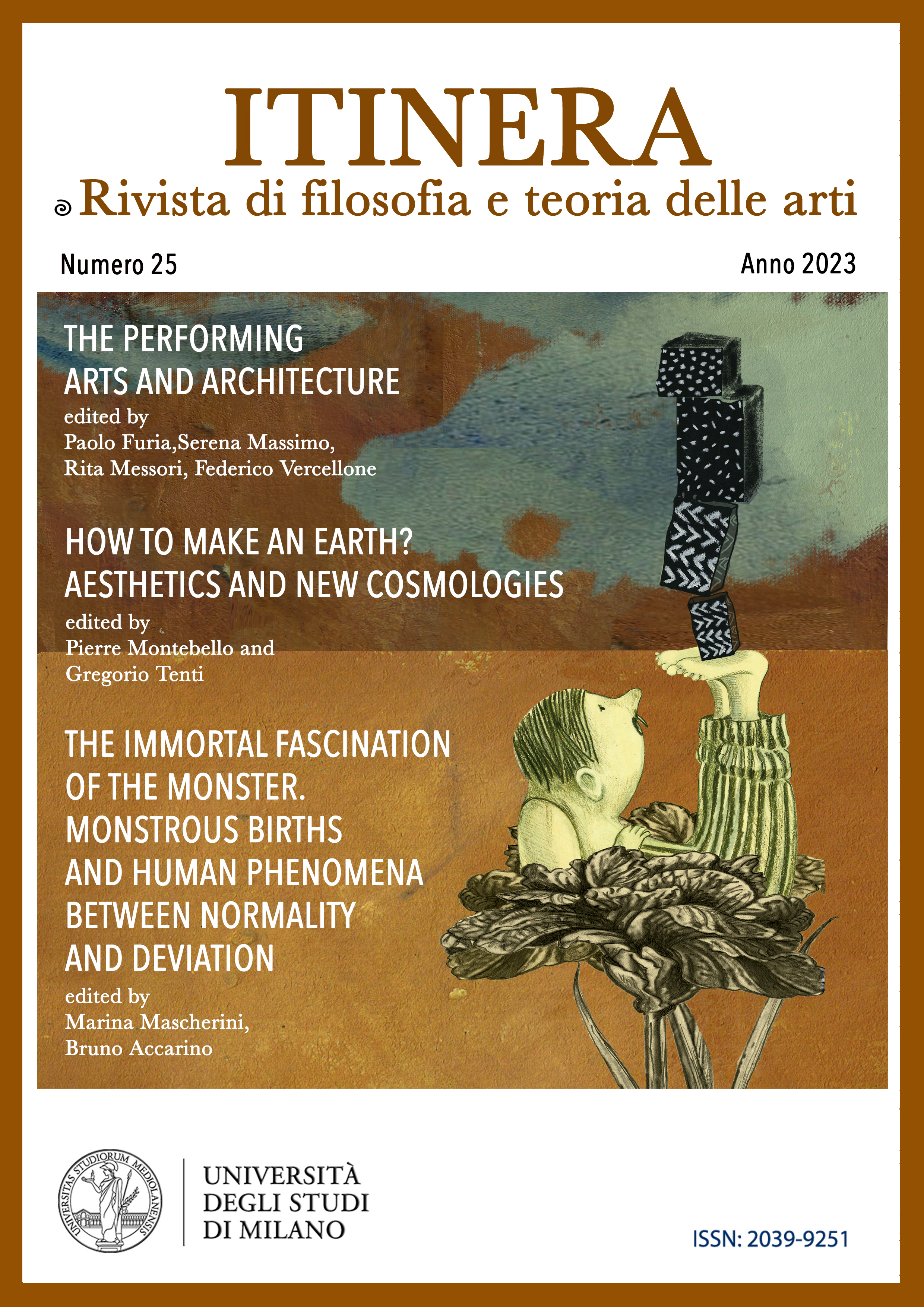L’enigma dell’ombra: l’ombra portata come misura e presenza dell’altro
DOI:
https://doi.org/10.54103/2039-9251/20785Parole chiave:
Denis Diderot, Carmelo Rifici, theatre, acting, aesthetics of theatreAbstract
Shadow, a physical phenomenon that we experience every day and is intuitively easy to understand, does not seem to hide great mysteries. However, through the study of texts and works of Western figurative art, a different reality linked to its use can be observed. In fact, the presence of shadow in Western art and representation is profoundly discontinuous and non-linear, and it does not become more frequent with a greater mastery of representation techniques. There are authors who were knowledgeable about and studied the phenomenon in detail but nonetheless advised against its use or avoided it altogether.
For these reasons, we have decided to delve into the use and representation of shadow in figurative art and its significance, focusing specifically on two distinct artistic techniques. The objective of this article is to demonstrate: 1) that the use of shadow in figurative art and representation is not simply a coincidental fact or a mere attempt to imitate reality, but rather reveals a specific conscious intention of the artist to represent; 2) that there is a difference in the use of cast shadow, particularly regarding the presence or absence of the subject casting the shadow within the framed and represented scene.
To support this thesis, an interdisciplinary analysis of two examples is conducted, one from painting and one from cinema. However, due to the vastness of the time span and examples, it was necessary to narrow down the scope of research by limiting the analysis to two examples from the 20th century in painting and cinema: Giorgio de Chirico (1888 – 1978) and Ingmar Bergman (1918 – 2007).
Riferimenti bibliografici
Bergman, I., Persona, Svensk Filmindustri, Svezia 1966.
De Chirico, G., Ebdòmero, SE, Milano 1999.
Dal Sasso, D., Paura e sottrazione dal mondo. Una lettura di "Persona" di Ingmar Bergman, in “Filosofia”, (61). https://doi.org/10.13135/2704-819
De Giusti, L., Monica e il desiderio, in A. Costa (a cura di) Ingmar Bergman, Marsilio, Venezia 2008, pp. 27-45.
Deleuze, G., L’immagine-movimento. Cinema 1, Einaudi, Torino 1983.
De Sanna, J., De Chirico, la metafisica del Mediterraneo, Rizzoli, Milano 1988.
Fabbri, P., L’Ombra. De Chirico e Warhol, in “Paolo Fabbri Semiotica online”, https://www.paolofabbri.it/corsi-e-lezioni/dechirico_warhol/.
Farinelli, F., Geografia, Einaudi, Torino 2003.
Gaio Plinio Secondo, Naturalis Historia, in S. Ferri, Storia delle arti antiche, BUR, Milano 2000.
Godard, J-L., Monika, “Arts”, n. 680, 30 luglio 1958, in J. Mandelbaum, Ingmar Bergman, “Cahiers du Cinèma”, 2011.
Gombrich, E., Ombre, Einaudi, Torino 1996.
Leonardo da Vinci, Trattato della pittura, a cura di A. P. McMahon, Princeton University Press, Princeton 1956.
Mori, G., De Chirico metafisico, Giunti editore, Milano 2006.
Porro, M., Ombra, in “Doppiozero”, 18 agosto 2017, https://www.doppiozero.com/materiali/ombra
Publio Ovidio Nasone, Le Metamorfosi, trad. it. G. Faranda Villa, BUR, Milano 1994.
Spagnoletto, D., Giorgio De Chirico: La geometria al servizio della Metafisica, “Metafisica”, (11-13), 2013, pp. 87-121.
Stoichita, I. V., Breve storia dell’ombra, il Saggiatore, Milano 2015.
Thrall Soby, J., Giorgio de Chirico, Arno Press, New York 1966.
Vasari G, Le vite de' più eccellenti pittori, scultori e architetti, scritte da Giorgio Vasari pittore aretino, con nuove annotazioni e commenti di Gaetano Milanesi, G. C. Sassoni, Firenze 1878.
Dowloads
Pubblicato
Fascicolo
Sezione
Licenza
Copyright (c) 2023 Lorenzo Stefano Iannizzotto

Questo lavoro è fornito con la licenza Creative Commons Attribuzione - Condividi allo stesso modo 4.0.
Gli autori che pubblicano su questa rivista accettano le seguenti condizioni:
1. Gli autori mantengono i diritti sulla loro opera e cedono alla rivista il diritto di prima pubblicazione dell'opera, contemporaneamente licenziata sotto una Licenza Creative Commons - Attribuzione - Condividi allo stesso modo 4.0 internazionale che permette ad altri di condividere l'opera indicando la paternità intellettuale e la prima pubblicazione su questa rivista.
2. Gli autori possono aderire ad altri accordi di licenza non esclusiva per la distribuzione della versione dell'opera pubblicata (es. depositarla in un archivio istituzionale o pubblicarla in una monografia), a patto di indicare che la prima pubblicazione è avvenuta su questa rivista.
3. Gli autori possono diffondere la loro opera online (es. in repository istituzionali o nel loro sito web) prima e durante il processo di submission, poiché può portare a scambi produttivi e aumentare le citazioni dell'opera pubblicata (Vedi The Effect of Open Access).





